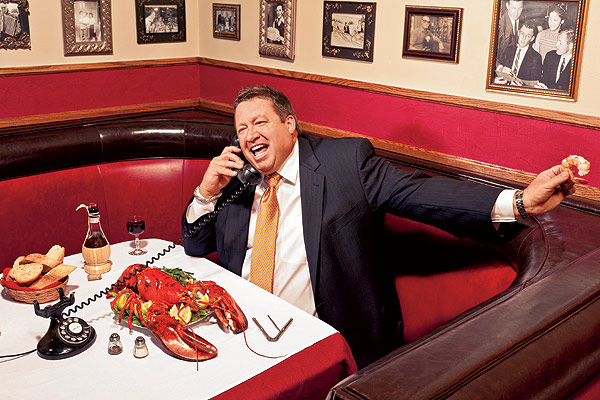
“I loved it and also I was a wreck,” says Scott Harris of Mia Francesca, one of his more than 20 restaurants. “It was my first place, my dream restaurant, and I was worried all the time that it wasn’t going to succeed.”
Related:
MORE ON SOME OF HARRIS’S RESTAURANTS
Davanti Enoteca »
The Purple Pig »
Ethyl’s Beer & Wine Dive »
At a table at Francesca’s on Chestnut, Scott Harris—his six-foot-one, 300-pound frame decked out in shorts and a sports shirt—is hunkered down, intensely studying the menu. It’s an unusual sight. After all, Harris, 50, is a Chicago restaurant mogul, the owner and executive chef of the Chicago-based Francesca restaurant chain, as well as a partner in multiple other local eateries, including the highly praised Davanti Enoteca and The Purple Pig. He could recite this menu in his sleep, since he created it for his first restaurant, Mia Francesca, in 1992. And today he’s already ordered lunch—carpaccio and a half order of gnocchi—so, for once, the food isn’t capturing his attention. Rather, it is the graphic design of the menu that is making him pause.
First he examines the long-established template that is used in all 20 of the Francesca venues in Chicago and the suburbs—plus an outpost in Madison, Wisconsin. This broadsheet, with a narrow black-and-white image of a beguiling woman’s face at the top, has half of the culinary offerings printed by hand. Then he picks up a spec design for a new Francesca menu. It is also a broadsheet with the same food items. But there the similarities end. The handwriting has been replaced with a script font, and a black-and-red collage of women’s faces borders the page. The first menu looks like it belongs in an Italian trattoria; the other looks like it could be found in a franchised restaurant in Anytown, USA. The first look is indicative of Harris’s winning formula: great Italian food at reasonable prices, with a helping of homey charm. The second look is a proposal from Reconstruction Partners, a Nashville-based management team whose claim to fame is the franchising and expansion of Sonic, a chain of drive-ins.
* * *
Harris has hired Reconstruction Partners to help him as he begins a national expansion of his signature restaurant. This fall, he will be opening one Francesca’s in Scottsdale, Arizona, one in San Diego, California (plus a Davanti Enoteca in that city’s well-established Little Italy neighborhood), and one in Raleigh, North Carolina. On the drawing board are six more and seven new “affiliates”—restaurants in which Harris has a stake. Ultimately, Harris wants to ramp up his reach and solidify his business into a national dining juggernaut, one that will not only provide future security to his family (which, by Harris’s definition, includes his longtime employees) but also allow him to step away from the daily frenzy.
“I hate the word ‘corporate,’ but I have to get a little more corporate,” he says, explaining why he’s brought in an outside team to help restructure his dining empire. “I’ve been running all of this like individual mom-and-pop restaurants. I want to keep that mom-and-pop flavor but do it on a much bigger scale.” One of the first suggestions from his corporate team: Change the look of the menu.
“Do you think this handwritten menu looks sloppy?” he asks, waving the original. “Is it hard to read? I like it, but I’ve been told that we should go more to this printed style for the expansion. It’s supposed to be neater and easier to read.” Such are the challenges that Harris now faces as he moves beyond his local roots. Can a multistate operation keep its original emphasis on quality and neighborhood charm?
It is one thing to be the master of a boom of restaurants in your hometown—no one except Lettuce Entertain You honcho Rich Melman has accomplished as much as Harris has here—and quite another to successfully replicate those venues in other cities with different tastes and cultures. Particularly in this economy. According to data released by NPD Group, a market research company based in New York, the past several years have been the worst for the restaurant business since NPD started tracking the industry in 1976: In May 2010, after eight consecutive quarters of decline, total restaurant visits reached a plateau, compared with a 3 percent loss the year before. But the Francesca operation has bucked that trend. In 2009, it grossed $42 million. The next year, gross sales rose to $48 million, a 14.5 percent increase. The first half of 2011 shows a growth of over 4 percent.
Expansion in the restaurant business usually doesn’t occur during a recession, but then Harris has never played by the rules. “His concept of Mia Francesca was a total refinement of what was being done at the time,” says the Chicago Tribune restaurant critic Phil Vettel. “Instead of big, elaborate dishes, he offered a couple of pizzas, a couple of pastas, not much beef. And the atmosphere was relaxed. The food was more sophisticated than it seemed, yet everything was geared to put the diner at ease—right down to the handwritten menu.” In the last nine months, Harris has also opened DiSotto Enoteca, a late-night wine and charcuterie spot downstairs from Francesca’s on Chestnut, and Dough Boys, a pizza counter and delivery operation in the Little Italy neighborhood. “He’s feeding half of Chicago every night,” says Penny Pollack, Chicago magazine’s dining editor.
He has had some recent failures along the way, too, but sentimentality doesn’t seem to paralyze him. If things aren’t working out, he makes big changes quickly. Aldino’s, his traditional Italian restaurant in Little Italy, opened in 2010 and garnered excellent reviews, but it couldn’t pull in any crowds. Four months in, Harris shut it down and retooled the concept into the current Salatino’s, bringing in Joe Farina, the longtime chef at Rosebud, and shifting to what Harris calls “a red gravy, Sopranos-style” menu. His T-Bones Steakhouse in St. Charles also didn’t find its market, so Harris changed his vision and opened Fat Rosie’s Taco & Tequila Bar in the same space.
“He may just be the most underrated restaurateur in the country,” says Jimmy Bannos Sr., owner of the New Orleans–style Heaven on Seven and Harris’s partner in The Purple Pig. Clearly, Harris likes to keep a lot of plates spinning.
* * *
Photograph: Saverio Truglia; Prop Styling: Angela Finney; Food Styling: Joseph Farina; Make-up: Morgan Blaul
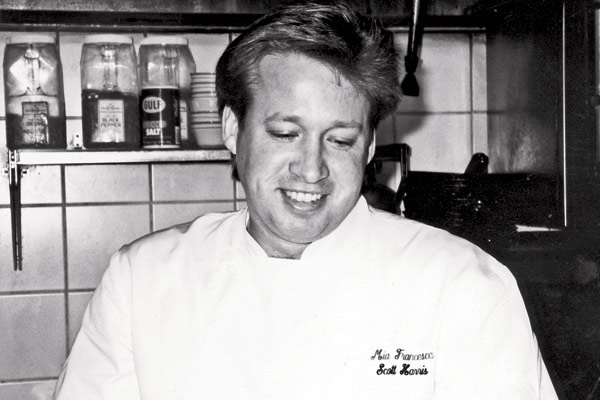
Harris behind the stove at the original Mia Francesca
Related:
MORE ON SOME OF HARRIS’S RESTAURANTS
Davanti Enoteca »
The Purple Pig »
Ethyl’s Beer & Wine Dive »
Even this afternoon is a major juggling act. Later he’ll stop in and check on Ethyl’s Beer and Wine Dive, his new bar with a chef-driven menu on South Racine Avenue. But first it’s time to pick out a name for his new doughnut shop, which is going in the lower level of Francesca’s Forno in Wicker Park. He pulls out his BlackBerry and scrolls through his notes. “The name I like is Glazed.”
“Oh, you can’t have Glazed,” says Robyn Jones, operations manager of Mia Francesca Corporation. “We found out it’s taken.”
He groans loudly. “But I loved Glazed. Glazed was the name. That was it.” Then, as quickly as throwing a switch, he is over his disappointment. He starts scrolling through his BlackBerry again. “OK, it’s either Sticky Fingers or Hole Lotta Love. What do we like?” (In the end, Harris settled on Glazed and Confused.) Looking across the room, he sees Tony Mantuano, the lauded chef/partner of Spiaggia, Chicago’s only four-star Italian restaurant. Mantuano has just arrived for a meeting with Harris and the other Purple Pig partners.
“Let me ask you something before we go to the meeting,” Harris says to Mantuano, handing him the spec menu. “They’re suggesting we use this new design to replace the handwritten Francesca menu. What do you think of it?”
Mantuano answers quickly. “I hate it.”
“Yeah,” says Harris. “I’m not feeling it either.”
* * *
“Scott has always had very strong gut feelings about things,” says Michael Noone, one of the three major partners in Mia Francesca Corporation and co-owner of Danny’s Tavern, a Bucktown late-night institution. “But he also has a solid working sense of all aspects of the hospitality industry. He gets the back of the house, the front, the line, the staff. I haven’t worked with anyone else who has such a comprehensive understanding.”
Noone first met Harris at Danny’s, which he owns with Terry Alexander. (Today, Noone also is a partner in two bars, Streetside and Simone’s, and Alexander is a partner in various restaurants, including The Publican, Big Star, and The Violet Hour, a luxe cocktail bar.) It was the early 1990s, and Harris was the executive chef at Trattoria L’Angolo di Roma in Lincoln Park. After finishing the dinner shift, the whole di Roma staff would head to Danny’s. Eventually, Harris asked Carol Watson, a friend of Noone’s and Alexander’s who was hostessing at di Roma (she now owns Milk & Honey, a café/restaurant in Wicker Park), to set up a meeting. The three men met at O’Famé.
“Scott said he didn’t want to work for anyone anymore,” recalls Noone. “He wanted his own Italian restaurant, and he wanted us to partner with him—he’d run the kitchen, we’d do the bar, and his wife would work the door.” The three discussed their philosophy, Harris pushing the idea of casual, authentic Italian dining. At the time, the high-profile Italian restaurants—Sole Mio, Avanzare—were flashy and expensive, and Harris was looking for a counterpoint. Then the three studied a map of Chicago. “We picked an area—Lake Shore Drive on the east, Diversey on the south, Southport on the west, and Irving Park on the north. It seemed underserved for reasonable Italian food.” Looking for properties, the group found a shuttered place on Clark Street, just north of Belmont Avenue. The owner had closed the business, Ideal Candies, several years earlier when his wife died. Now he was ready to unload it.
The three men ponied up $50,000 each. Noone and Alexander used all the savings they had accumulated for a future bar, then borrowed from their families. “It all just clicked with us,” says Noone. “Scott’s vision and his passion were compelling enough to take the risk.” Harris had inherited some money from his father, who had been killed by a drunk driver, and he borrowed $32,000 from his 82-year-old grandmother, Bernadette. “It was all the savings she had,” remembers Harris. “Just taking it almost gave me a heart attack.”
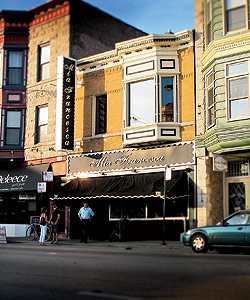 Where the Scott Harris empire began: The original Mia Francesca, which opened in 1992, at 3311 North Clark Street in Lake ViewThey kept the tin ceiling of the candy store, turned the old soda fountain into a bar, and packed in 75 seats, putting diners elbow to elbow, which made for an ear- splitting din. The menu was value driven, with a massive bowl of linguini with porcini and portobello mushrooms costing $8; tiramisù, $3; and a glass of wine, $4. After opening in February 1992, the place quickly found an adoring audience. Within three months, the two-hour wait for tables was spilling out the door and down the sidewalk. After just six months, Harris had paid his grandmother—who came to the restaurant carrying her own cushion for the wooden chairs—back in full. Noone remembers it as “a magical time in all of our lives,” with the partners working hard together and seeing their dream become a hot, trendy reality. Others remember Harris having meltdowns over the line in back, demanding perfection in the food leaving the kitchen. “I loved it and also I was a wreck,” says Harris. “It was my first place, my dream restaurant, and I was worried all the time that it wasn’t going to succeed.” He recalls waiting for the first big review, by the Trib’s Vettel, which came out in September. “I was walking out of our home in Oak Park at dawn, wearing a bathrobe, looking for the papers to be delivered. Finally, I found one, and the first sentence of the review Phil Vettel wrote was, ‘Why would anyone go to this place?’ It was like a knife in my heart.”
Where the Scott Harris empire began: The original Mia Francesca, which opened in 1992, at 3311 North Clark Street in Lake ViewThey kept the tin ceiling of the candy store, turned the old soda fountain into a bar, and packed in 75 seats, putting diners elbow to elbow, which made for an ear- splitting din. The menu was value driven, with a massive bowl of linguini with porcini and portobello mushrooms costing $8; tiramisù, $3; and a glass of wine, $4. After opening in February 1992, the place quickly found an adoring audience. Within three months, the two-hour wait for tables was spilling out the door and down the sidewalk. After just six months, Harris had paid his grandmother—who came to the restaurant carrying her own cushion for the wooden chairs—back in full. Noone remembers it as “a magical time in all of our lives,” with the partners working hard together and seeing their dream become a hot, trendy reality. Others remember Harris having meltdowns over the line in back, demanding perfection in the food leaving the kitchen. “I loved it and also I was a wreck,” says Harris. “It was my first place, my dream restaurant, and I was worried all the time that it wasn’t going to succeed.” He recalls waiting for the first big review, by the Trib’s Vettel, which came out in September. “I was walking out of our home in Oak Park at dawn, wearing a bathrobe, looking for the papers to be delivered. Finally, I found one, and the first sentence of the review Phil Vettel wrote was, ‘Why would anyone go to this place?’ It was like a knife in my heart.”
Actually, that wasn’t the first sentence in Vettel’s review. But he did write, in the second paragraph, that while Mia Francesca was a “neighborhood gem,” it was “popular beyond reason. As a result, the restaurant is so crowded, so noisy, so tough a ticket that dining here becomes a test of patience, endurance and will.” But the customers didn’t seem to mind. The crowds just became part of the mise en scène. By the end of 1992, the dining editors at Chicago magazine gave Mia Francesca their Rookie of the Year award. Two years later, Harris, Noone, and Alexander opened La Sorella di Francesca in Naperville, and a winning formula began to blanket the city and the suburbs.
According to Noone, one of the primary reasons for the current restructuring of the Mia Francesca Corporation, which is still owned by the three main partners, plus 12 minority partners, is that all the restaurants were opened individually. “Now we’ve got 21 different entities,” he says. “We need to roll them into one. Financial institutions don’t like to lend to small start-up restaurants, so in order for us to expand nationally, we need to show our strength.” Key to a successful expansion, says Noone, is breeding the Francesca culture from the top down in every location. “Obviously, Scott can’t be everywhere anymore. So the attitude will have to come from the top, and you have to have all your servers, your bartenders, and your managers emulate Scott and his values.” The goal is to create Harris clones who can bring the same attention to detail, passion for food, and high standards for service to every location in every state.
As for compromise, Noone says the partners faced an early challenge of bowing to local customs. “At Mia Francesca, we used short, nonstemmed glasses as wineglasses, just like they do in Italian trattorias. No one else was doing it at the time, but it was authentic. Then we opened in Naperville, and no one there liked them. Customers kept asking for stemware, and eventually people even started bringing their own stemware to the restaurant. So we decided, OK, we’ll provide stemware. But there are some things you can’t compromise on, either. We know that. Or you just lose what you had that was so special in the beginning.”
* * *
Photography: (Harris) Courtesy of the Harris family; (Mia Francesca) Kim Thornton
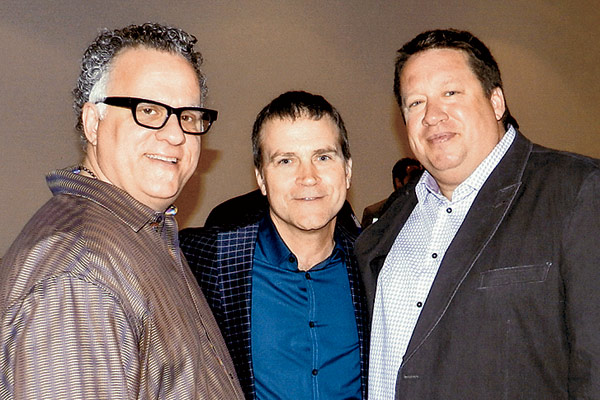
(From left) Jimmy Bannos Sr. and Michael Noone with Harris at a restaurant awards event earlier this year
Related:
MORE ON SOME OF HARRIS’S RESTAURANTS
Davanti Enoteca »
The Purple Pig »
Ethyl’s Beer & Wine Dive »
It is dim and quiet in DiSotto Enoteca—the place doesn’t open to customers for hours—so it’s a perfect spot for a Purple Pig partners’ meeting. The Purple Pig, on Michigan Avenue at Illinois Street, opened last year with the slogan “Cheese, Swine & Wine.” It specializes in small plates of Mediterranean cuisine and offers a vast selection of Greek wines and grappa. Bon Appétit named it one of the ten best new restaurants of the year—and it was the only Chicago place on the list. A possibility the partners are considering: opening Purple Pigs in other cities and states.
Harris sits at the head of the table, with his longtime friend Jimmy Bannos Sr. on his right, then Tony Mantuano and, across the table, Jimmy Bannos Jr., the Pig’s chef. It is a gathering of equals, although Harris is the one, nominally at least, who runs the meeting. There is a printed agenda—beverage team restructure, public relations, and procedure updates—but the conversation quickly veers off course. “We’re thinking we want to open a speakeasy kind of place downtown,” Harris tells Mantuano.
Bannos Jr. jumps in. “Big, cheap, late hours, totally hidden. No sign, just an arrow pointing to the place.”
“Who’s going to find it? No one will know the place exists,” says Mantuano.
Harris describes how to get to an unmarked bar in Chinatown, adding, “On the outside, you’d never know what was going on. But inside, the staff is wearing lab coats and serving drinks in test tubes.”
“I’m against that,” says Mantuano.
“No, we’re not doing that.” Harris waves his hand in dismissal. “We’re going totally old school here—big old leather booths, lots of atmosphere.”
“We’d be serving cheap drinks like Rolling Rock,” says Bannos Jr. “Go total old style.”
“Old school, not old style,” says Harris.
The idea of opening a companion place to The Purple Pig is brought up. Harris wants white wine, Champagne, and oysters; the Bannoses want it to be Italian.
“This isn’t the time for an Italian restaurant,” says Mantuano. “At the most, maybe a spaghetti bar.”
“Are you crazy?” says Bannos Sr. “There’s a huge market in this town for Italian food. Huge.”
“No, no,” counters Harris. “Something light and white, something for the ladies. The big question is, do we go with investors or bankers?” That is left unanswered. Shifting gears effortlessly, Harris says, “Let’s go to Europe for some research. Four days of restaurant tastings.” Everyone pulls out a BlackBerry, and dates are tossed around. Finally, there is agreement on a trip to London, Paris, and Madrid. Then Harris announces, “Look, I’m restructuring everything financially. We’re streamlining the bookkeeping, we’re putting things in a more orderly fashion.”
“What does this mean?” says Bannos Sr. “If I want to write myself a check for $20,000, I’m not going to jump through hoops.”
“No, no, no,” says Harris. “This is going to be good for all of us. If we want to move forward, expand our ideas, open new places in different cities, then we have to get everything in order.”
“I don’t like it,” says Bannos Sr., who operates in a loose and casual fashion. “Paperwork, nitty-gritty little details—I can’t stand it.”
“You’ll love it,” says Harris.
* * *
Photograph: Courtesy of the Harris family

Harris, pictured at 17, worked as a fry cook in high school and soon after graduating realized he wanted to be a chef.Scott Harris grew up on Chicago’s South Side and in Mokena, the oldest of five children. His father was a third-generation carpenter, and his mother was a Harris, pictured at 17, worked as a fry cook in high school and soon after graduating realized he wanted to be a chefzwaitress. Starting after sixth grade, Harris worked every summer with his dad on construction jobs. “I hated it. Bricklaying, cement work, carrying wood. I knew it wasn’t the life for me.” When he was 12, he started tagging along with his mother to her job at Fox’s Pub in Orland Park. “I looked older than I was, so I got a job washing dishes.” After a few months, the chef took Harris under his wing. “His name was Stretch, and he was a 400-pound bearded hippie, but he took an interest in me and started showing me things in the kitchen.” The food at home wasn’t great—except for Thanksgiving and his mother’s roasted chicken—but he quickly became intrigued with cooking.
From there, Harris moved to Jeremiah Sweeney’s on the South Side, manning the fry station at the age of 17. “I loved it. You know, restaurant people are a different breed.” When he graduated from high school, he tried to get a job at ComEd, but that didn’t work out. So he decided to go to Joliet Junior College. A guidance counselor talked to him briefly and then walked him over to the culinary department, saying, “This is where you belong.” “I wish I could find that guy today,” says Harris. “I owe him.”
After graduation, he moved downtown and found work at The 95th. Then he started hopping from job to job, choosing experience over stability and high wages. He relocated to St. Croix for two years, cooking at a resort, and then worked at Ambria, Avanzare, Cityscape, Chez Jenny. He was French trained, but when he had a chance to be the chef at Trattoria L’Angolo di Roma, at Belden Avenue and Clark Street, he jumped at it. “It opened the world to me. I fell in love with the whole concept of Italian cooking—pasta, fish, a few ingredients, fresh flavors,” Harris says.
Related:
MORE ON SOME OF HARRIS’S RESTAURANTS
Davanti Enoteca »
The Purple Pig »
Ethyl’s Beer & Wine Dive »
He met Francesca Pignataro through his best friend, who had married her sister. On their second date, she told him she didn’t want to have children, so if he did, they should just remain friends. “At the time, I could barely pay my own bills,” recalls Harris. “I was driving my late dad’s ’86 Mercury Marquis—how would I ever have the money to have kids?” They married in 1990. By the time Harris was 34, he had opened three Francesca restaurants, and money was no longer an issue. “I told her, ‘I think I’ve changed my mind about kids.’ And she said, ‘I haven’t.’” They divorced in 2000, although she remains active with the Mia Francesca Corporation.
A baptism brought Harris and Dana Chrisos together. He was the godfather of twins, and she was a young Chicago native visiting from her new home in California. She worked in the hospitality industry for Hyatt Hotels, and she had two kids, a four-year-old daughter and a two-year-old son. Over the years, Harris and Chrisos began a long-distance relationship, and on New Year’s Eve 2009, they married. Jimmy Bannos Sr. was the best man—Harris borrowed his ring for the courtroom ceremony, after which the wedding party had lunch at RL. Later that evening, there was a celebration at The Purple Pig.
“I’ve never been happier,” he says. “People say, ‘Oh, the long-distance thing will never work out.’ But it truly does make the heart grow fonder.”
* * *
It’s not always easy to get a seat at Davanti Enoteca, the Little Italy gem that Chicago named Harris’s “masterpiece.” But when you walk in with the boss and his wife, it helps. “We’re fresh from the gym,” says Harris after asking the waiter to send “a bunch of everything” to the table. “I’ve got a trainer now, and he’s killing me.” The trainer is, in large part, the influence of Dana Chrisos-Harris, 45, a tall, slender brunette with an easygoing manner. She has also influenced Harris’s interest in expanding westward. Her daughter, Sophia, now 17, and son, Andrew, 15, currently live in San Diego, and Harris, through his commuter marriage, has fallen in love with the city. “I’m ecstatic that Scott is going to have some restaurants in San Diego,” Chrisos-Harris says. “And the kids are very happy, too.”
“Hey, do you have that spec menu—the one they want me to use when we go national?” Harris asks her. “I want to show it to somebody here.”
“I tore it up. It may be in the back seat of your car now.”
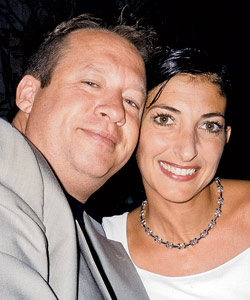
In 2009 Harris embarked on a commuter marriage with Dana Chrisos of San Diego, where he will open two restaurants later this year.Decision made. “It wasn’t for me,” says Harris. A few moments later, he adds, “Dana is pushing me to change. She’s pushing me to sell early so we can have some leisure time together.”
“I want him to go where his passions take him,” she says. “But I don’t like to see him stressed.”
“I want to enjoy my fifties,” he says. “So I have a five-year exit strategy and a ten-year exit strategy, and we’ll see what happens.”
But can a guy who is perpetually in motion ever slow down?
“Sure I can. Of course. I just want to do a few more things.” Then Harris launches into his ideas for Chicago’s Little Italy, how he has developed a ten-year plan for Taylor Street that includes “a killer bakery that does wedding cakes, a Sicilian fish house, a gelato and bombolini shop, a meatball shop with a dozen different types of meatballs, and, finally, another restaurant.” This one would be called Mia Modo, meaning “my way.” “I would just feed you what I wanted to, no menu. Just a little 50-seat place that gives new meaning to the term ‘chef-driven.’” He would also like historical-looking signs on Morgan Street and Ashland Avenue, officially naming the area Little Italy. He would have farmers’ markets there, and—if he had his way—he’d tear up Taylor Street and repave it with cobblestones. “OK, I may not get the cobblestones,” he admits.
When I mention that this doesn’t sound like a man preparing to enjoy his leisure time, Harris gives a little shrug. “Scott has to be Scott,” says Chrisos-Harris. “If he changes too much, then he isn’t Scott.”
The same could be said about Harris’s restaurants as he begins a national expansion. “I want to go to the next level, but we’re not talking Olive Garden here,” he says. “I don’t know everything, but I do know how to do a great restaurant, a restaurant people love. And I’m just trying to share the love.”
Photograph: Courtesy of the Harris Family



Comments are closed.